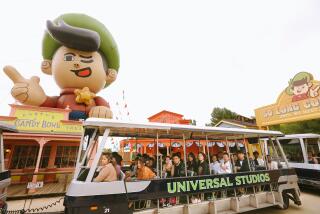Revolution restoration to return Six Flags Magic Mountain coaster to its rightful glory
They said it would never happen.
Six Flags Magic Mountain will remove the universally despised over-the-shoulder restraints on the Revolution roller coaster and replace them with modern snug-fitting lap bars in 2016.
IN THE LOOP: Sign up for our weekly theme parks newsletter
In honor of Revolution’s 40th anniversary, the Valencia amusement park will give the track a new paint job, update the aging station, install new trains on the existing coaster chassis and add new restraints similar to the ones used on Full Throttle and Twisted Colossus.
It’s about time. Heartbroken fans have been complaining for decades that the legendary coaster is painfully unrideable. Disdain for the head-banging restraints installed in 1992 inspired a Change.org petition and a “Restore Revolution” Facebook page. The last time I rode Revolution, the hard rubber restraints boxed my ears 24 times (I counted) and left me with an ear-ringing headache.
Tim Burkhart, the coaster guru for all of Six Flags who previously held a similar lofty title at Magic Mountain, hated talking about Revolution’s over-the-shoulder restraints. He personally despised the medieval torture devices just as much as coaster enthusiasts, who asked him ad nauseum about their removal. On more than one occasion Burkhart told me that the over-the-shoulder restraints on Revolution were state mandated and would never, ever come off.
The situation was always confusing to coaster fans, in part because Revolution started life in 1976 with simple lap bars. Plenty of similar coasters from that era never had to add the over-the-shoulder restraints. Exhibit A was always Sooperdooperlooper at Pennsylvania’s Hersheypark, a 1977 Schwarzkopf terrain coaster with a single vertical loop and the original lap-bar-only restraints.
But Revolution was in California, and therefore had to abide by the dictates of the state’s Division of Occupational Safety and Health (DOSH), better known as Cal/OSHA. But you can thank Twisted Colossus and Full Throttle for the bureaucratic change of heart: Both coasters navigate multiple inversions with riders restrained by only tight-fitting lap bars.
Back in 1976, the $2-million Revolution was made by Germany’s Schwarzkopf and billed as the world’s first modern vertical looping coaster. At 113 feet tall, the one-time tallest coaster in the world seems almost sedate by today’s thrill ride standards. Revolution’s 55 mph trek through wooded terrain features an almost comically dramatic long straightaway approach toward a once-imposing 90-foot-tall loop.
Revolution’s debut in May 1976 sparked a decades-long coaster arms race that still continues to this day. The triple-inversion Corkscrew by Arrow Dynamics opened a week later at Ohio’s Cedar Point with a vertical loop and double corkscrew. Cedar Point and Magic Mountain have been battling over the title of Roller Coaster Capital of the World ever since. Magic Mountain currently holds a seemingly insurmountable lead, with 19 coasters to Cedar Point’s 16.
Revolution certainly was not the world’s first looping coaster or even the first modern inverting coaster. (An inversion, in coaster-speak, means to go upside down.) The 1975 Corkscrew at Knott’s Berry Farm in Buena Park featured a double corkscrew, making it the world’s first modern inverting coaster. The teardrop-shaped clothoid loop on Revolution made the Magic Mountain ride the world’s first modern vertically looping coaster.
“Modern” is the key word in the titles bestowed on both Revolution and Corkscrew. The history of the looping coaster dates back to the late 1800s and early 1900s, with the 1901 Loop the Loop at New York’s Coney Island the most prominent example. But those classic coasters featured circular-shaped loops and flat train-like tracks while the modern coasters employed elliptical-shaped loops and tubular steel tracks.
The Magic Mountain coaster started life as the Great American Revolution, paying tribute to America’s bicentennial. By 1979, when Six Flags took over the park, the ride’s name changed to La Revolucion, transforming the revolutionary reference from American to Mexican. In 1988, the moniker was shortened to simply Revolution. Magic Mountain is rechristening the ride New Revolution for the 2016 makeover.
The ride found cinematic fame in 1977’s “Rollercoaster,” 1978’s “Kiss Meets the Phantom” and 1983’s “National Lampoon’s Vacation.” In 2002, Revolution received landmark recognition from American Coaster Enthusiasts, a distinction that likely won’t change as the ride is brought back to its original configuration.
Today, Revolution is one of the least popular coasters at Magic Mountain, with visitors rarely waiting more than one or two cycles to climb aboard the historic ride. Hopefully the restoration returns Revolution to its rightful glory and extends the life of the aging ride.
As Revolution moves into middle age, the legendary ride is poised to become the ideal family coaster for parents anxious to introduce their kids to the thrill ride of their youth. And it’s also the perfect opportunity for a teaching moment: Never say never.
Magic Mountain plans to close Revolution on Monday to begin the transformation.
MORE
32 best new theme park additions of 2015
8 unanswered questions about Disneyland’s Star Wars Land
Disneyland 2055: What the future may hold for the original Disney park
After Disneyland’s nightmare start in 1955, ‘Walt’s Folly’ quickly won over fans
21 creepiest abandoned amusement parks
> Sign-up for our weekly In the Loop theme park newsletter
> Follow the Los Angeles Times Funland theme park blog on Twitter, Facebook, Google+ and Instagram
More to Read
Sign up for The Wild
We’ll help you find the best places to hike, bike and run, as well as the perfect silent spots for meditation and yoga.
You may occasionally receive promotional content from the Los Angeles Times.







